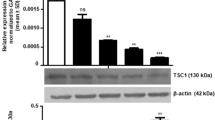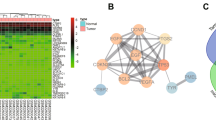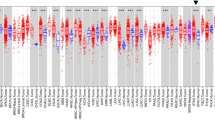Abstract
Oral cancer consists of squamous cell carcinoma within the oral cavity or on the lip. The clinical prognosis of this cancer is mostly poor owing to delayed diagnosis and a lack of appropriate early detection biomarkers to identify the disease. In the current study, we investigated the role of the S100A7 calcium-binding protein in oral squamous cell carcinoma as an activator of the p38/MAPK and RAB2A signaling pathway. The aim of the present study was to determine whether S100A7 and RAB2A have a role in tumor progression and to assess their potential as early detection biomarkers for oral cancer. This study elucidated the functional and molecular mechanisms of S100A7 and RAB2A activity in oral cancer, leading us to conclude that S100A7 is the major contributing factor in the occurrence of oral cancer and promotes local tumor progression by activating the MAPK signaling pathway via the RAB2A pathway. We hypothesize that S100A7 affects cell motility and invasion by regulating the RAB2A-associated MAPK signaling cascades. Also, the downregulation of S100A7 expression by RNA interference-mediated silencing inhibits oral cancer cell growth, migration and invasion.
This is a preview of subscription content, access via your institution
Access options
Subscribe to this journal
Receive 12 print issues and online access
$259.00 per year
only $21.58 per issue
Buy this article
- Purchase on Springer Link
- Instant access to full article PDF
Prices may be subject to local taxes which are calculated during checkout








Similar content being viewed by others
References
Kreeft AM, Tan IB, Leemans CR, Balm AJ . The surgical dilemma in advanced oral and oropharyngeal cancer: how we do it. Clin Otolaryngol 2011; 36: 260–266.
Ni YH, Ding L, Hu QG, Hua ZC . Potential biomarkers for oral squamous cell carcinoma: proteomics discovery and clinical validation. Proteomics Clin Appl 2015; 9: 86–97.
Mangalath U, Aslam SA, Abdul Khadar AH, Francis PG, Mikacha MS, Kalathingal JH . Recent trends in prevention of oral cancer. J Int Soc Prev Community Dent 2014; 4 (Suppl 3): S131–S138.
Perez-Sayans M, Somoza-Martin JM, Barros-Angueira F, Reboiras-Lopez MD, Gandara Rey JM, Garcia-Garcia A . Genetic and molecular alterations associated with oral squamous cell cancer (Review). Oncol Rep 2009; 22: 1277–1282.
Mishra A, Verma V . Oral sex and hpv: population based indications. Indian J Otolaryngol Head Neck Surg 2015; 67 (Suppl 1): 1–7.
Marur S, Forastiere AA . Head and neck cancer: changing epidemiology, diagnosis, and treatment. Mayo Clin Proc 2008; 83: 489–501.
Elango JK, Gangadharan P, Sumithra S, Kuriakose MA . Trends of head and neck cancers in urban and rural India. Asian Pac J Cancer Prev 2006; 7: 108–112.
Sankaranarayanan R, Masuyer E, Swaminathan R, Ferlay J, Whelan S . Head and neck cancer: a global perspective on epidemiology and prognosis. Anticancer Res 1998; 18: 4779–4786.
Dey KK, Pal I, Bharti R, Dey G, Kumar BN, Rajput S et al. Identification of RAB2A and PRDX1 as the potential biomarkers for oral squamous cell carcinoma using mass spectrometry-based comparative proteomic approach. Tumour Biol 2015; 36: 9829–9837.
Heizmann CW, Fritz G, Schafer BW . S100 proteins: structure, functions and pathology. Front Biosci 2002; 7: d1356–d1368.
Madsen P, Rasmussen HH, Leffers H, Honore B, Dejgaard K, Olsen E et al. Molecular cloning, occurrence, and expression of a novel partially secreted protein "psoriasin" that is highly up-regulated in psoriatic skin. J Invest Dermatol 1991; 97: 701–712.
Algermissen B, Sitzmann J, LeMotte P, Czarnetzki B . Differential expression of CRABP II, psoriasin and cytokeratin 1 mRNA in human skin diseases. Arch Dermatol Res 1996; 288: 426–430.
Jinquan T, Vorum H, Larsen CG, Madsen P, Rasmussen HH, Gesser B et al. Psoriasin: a novel chemotactic protein. J Invest Dermatol 1996; 107: 5–10.
Dey KK, Sarkar S, Pal I, Das S, Dey G, Bharti R et al. Mechanistic attributes of S100A7 (psoriasin) in resistance of anoikis resulting tumor progression in squamous cell carcinoma of the oral cavity. Cancer Cell Int 2015; 15: 74.
van Ruissen F, Jansen BJ, de Jongh GJ, van Vlijmen-Willems IM, Schalkwijk J . Differential gene expression in premalignant human epidermis revealed by cluster analysis of serial analysis of gene expression (SAGE) libraries. Faseb J 2002; 16: 246–248.
Olsen E, Rasmussen HH, Celis JE . Identification of proteins that are abnormally regulated in differentiated cultured human keratinocytes. Electrophoresis 1995; 16: 2241–2248.
Ostergaard M, Rasmussen HH, Nielsen HV, Vorum H, Orntoft TF, Wolf H et al. Proteome profiling of bladder squamous cell carcinomas: identification of markers that define their degree of differentiation. Cancer Res 1997; 57: 4111–4117.
Moog-Lutz C, Bouillet P, Regnier CH, Tomasetto C, Mattei MG, Chenard MP et al. Comparative expression of the psoriasin (S100A7) and S100C genes in breast carcinoma and co-localization to human chromosome 1q21-q22. Int J Cancer 1995; 63: 297–303.
Leygue E, Snell L, Hiller T, Dotzlaw H, Hole K, Murphy LC et al. Differential expression of psoriasin messenger RNA between in situ and invasive human breast carcinoma. Cancer Res 1996; 56: 4606–4609.
Enerback C, Porter DA, Seth P, Sgroi D, Gaudet J, Weremowicz S et al. Psoriasin expression in mammary epithelial cells in vitro and in vivo. Cancer Res 2002; 62: 43–47.
Al-Haddad S, Zhang Z, Leygue E, Snell L, Huang A, Niu Y et al. Psoriasin (S100A7) expression and invasive breast cancer. Am J Pathol 1999; 155: 2057–2066.
Nikitenko LL, Lloyd BH, Rudland PS, Fear S, Barraclough R . Localisation by in situ hybridisation of S100A4 (p9Ka) mRNA in primary human breast tumour specimens. Int J Cancer 2000; 86: 219–228.
Rasmussen HH, Orntoft TF, Wolf H, Celis JE . Towards a comprehensive database of proteins from the urine of patients with bladder cancer. J Urol 1996; 155: 2113–2119.
Di Nuzzo S, Sylva-Steenland RM, Koomen CW, de Rie MA, Das PK, Bos JD et al. Exposure to UVB induces accumulation of LFA-1+ T cells and enhanced expression of the chemokine psoriasin in normal human skin. Photochem Photobiol 2000; 72: 374–382.
Schaefer BM, Wallich R, Schmolke K, Fink W, Bechtel M, Reinartz J et al. Immunohistochemical and molecular characterization of cultured keratinocytes after dispase-mediated detachment from the growth substratum. Exp Dermatol 2000; 9: 58–64.
Zouboulis CC, Voorhees JJ, Orfanos CE, Tavakkol A . Topical all-trans retinoic acid (RA) induces an early, coordinated increase in RA-inducible skin-specific gene/psoriasin and cellular RA-binding protein II mRNA levels which precedes skin erythema. Arch Dermatol Res 1996; 288: 664–669.
Hoffmann HJ, Olsen E, Etzerodt M, Madsen P, Thogersen HC, Kruse T et al. Psoriasin binds calcium and is upregulated by calcium to levels that resemble those observed in normal skin. J Invest Dermatol 1994; 103: 370–375.
Tavakkol A, Zouboulis CC, Duell EA, Voorhees JJ . A retinoic acid-inducible skin-specific gene (RIS-1/psoriasin): molecular cloning and analysis of gene expression in human skin in vivo and cultured skin cells in vitro. Mol Biol Rep 1994; 20: 75–83.
Semprini S, Capon F, Bovolenta S, Bruscia E, Pizzuti A, Fabrizi G et al. Genomic structure, promoter characterisation and mutational analysis of the S100A7 gene: exclusion of a candidate for familial psoriasis susceptibility. Hum Genet 1999; 104: 130–134.
Angel P, Szabowski A, Schorpp-Kistner M . Function and regulation of AP-1 subunits in skin physiology and pathology. Oncogene 2001; 20: 2413–2423.
Karin M, Cao Y, Greten FR, Li ZW . NF-κB in cancer: from innocent bystander to major culprit. Nat Rev Cancer 2002; 2: 301–310.
Liu H, Wang L, Wang X, Cao Z, Yang Q, Zhang K . S100A7 enhances invasion of human breast cancer MDA-MB-468 cells through activation of nuclear factor-kappaB signaling. World J Surg Oncol 2013; 11: 93.
Emberley ED, Niu Y, Curtis L, Troup S, Mandal SK, Myers JN et al. The S100A7-c-Jun activation domain binding protein 1 pathway enhances prosurvival pathways in breast cancer. Cancer Res 2005; 65: 5696–5702.
Li T, Qi Z, Kong F, Li Y, Wang R, Zhang W et al. S100A7 acts as a dual regulator in promoting proliferation and suppressing squamous differentiation through GATA-3/caspase-14 pathway in A431 cells. Exp Dermatol 2015; 24: 342–348.
Nasser MW, Wani NA, Ahirwar DK, Powell CA, Ravi J, Elbaz M et al. RAGE mediates S100A7-induced breast cancer growth and metastasis by modulating the tumor microenvironment. Cancer Res 2015; 75: 974–985.
Shubbar E, Vegfors J, Carlstrom M, Petersson S, Enerback C . Psoriasin (S100A7) increases the expression of ROS and VEGF and acts through RAGE to promote endothelial cell proliferation. Breast Cancer Res Treat 2012; 134: 71–80.
Skliris GP, Lewis A, Emberley E, Peng B, Weebadda WK, Kemp A et al. Estrogen receptor-beta regulates psoriasin (S100A7) in human breast cancer. Breast Cancer Res Treat 2007; 104: 75–85.
Petersson S, Bylander A, Yhr M, Enerback C . S100A7 (psoriasin), highly expressed in ductal carcinoma in situ (DCIS), is regulated by IFN-gamma in mammary epithelial cells. BMC Cancer 2007; 7: 205.
West NR, Watson PH . S100A7 (psoriasin) is induced by the proinflammatory cytokines oncostatin-M and interleukin-6 in human breast cancer. Oncogene 2010; 29: 2083–2092.
Lapeire L, Hendrix A, Lambein K, Van Bockstal M, Braems G, Van Den Broecke R et al. Cancer-associated adipose tissue promotes breast cancer progression by paracrine oncostatin M and Jak/STAT3 signaling. Cancer Res 2014; 74: 6806–6819.
Deol YS, Nasser MW, Yu L, Zou X, Ganju RK . Tumor-suppressive effects of psoriasin (S100A7) are mediated through the beta-catenin/T cell factor 4 protein pathway in estrogen receptor-positive breast cancer cells. J Biol Chem 2011; 286: 44845–44854.
Sun J, Feng X, Gao S, Xiao Z . microRNA-338-3p functions as a tumor suppressor in human non-small-cell lung carcinoma and targets Ras-related protein 14. Mol Med Rep 2015; 11: 1400–1406.
Yoshida H, Miyachi M, Ouchi K, Kuwahara Y, Tsuchiya K, Iehara T et al. Identification of COL3A1 and RAB2A as novel translocation partner genes of PLAG1 in lipoblastoma. Genes Chromosomes Cancer 2014; 53: 606–611.
Nourashrafeddin S, Aarabi M, Modarressi MH, Rahmati M, Nouri M . The evaluation of WBP2NL-related genes expression in breast cancer. Pathol Oncol Res 2014; 21: 293–300.
Bai B, Hales CM, Chen PC, Gozal Y, Dammer EB, Fritz JJ et al. U1 small nuclear ribonucleoprotein complex and RNA splicing alterations in Alzheimer's disease. Proc Natl Acad Sci USA 2013; 110: 16562–16567.
Kumar BN, Rajput S, Dey KK, Parekh A, Das S, Mazumdar A et al. Celecoxib alleviates tamoxifen-instigated angiogenic effects by ROS-dependent VEGF/VEGFR2 autocrine signaling. BMC Cancer 2013; 13: 273.
Levine JJ, Stimson-Crider KM, Vertino PM . Effects of methylation on expression of TMS1/ASC in human breast cancer cells. Oncogene 2003; 22: 3475–3488.
Doan CC, Le LT, Hoang SN, Do SM, Le DV . Simultaneous silencing of VEGF and KSP by siRNA cocktail inhibits proliferation and induces apoptosis of hepatocellular carcinoma Hep3B cells. Biol Res 2014; 47: 70.
Bai B, Chen PC, Hales CM, Wu Z, Pagala V, High AA et al. Integrated approaches for analyzing U1-70 K cleavage in Alzheimer's disease. J Proteome Res 2014; 13: 4526–4534.
Pal I, Sarkar S, Rajput S, Dey KK, Chakraborty S, Dash R et al. BI-69A11 enhances susceptibility of colon cancer cells to mda-7/IL-24-induced growth inhibition by targeting Akt. Br J Cancer 2014; 111: 101–111.
Sarkar S, Mazumdar A, Dash R, Sarkar D, Fisher PB, Mandal M . ZD6474 enhances paclitaxel antiproliferative and apoptotic effects in breast carcinoma cells. J Cell Physiol 2011; 226: 375–384.
Venkatesan P, Bhutia SK, Singh AK, Das SK, Dash R, Chaudhury K et al. AEE788 potentiates celecoxib-induced growth inhibition and apoptosis in human colon cancer cells. Life Sci 2012; 91: 789–799.
Chen Z, Htay A, Dos Santos W, Gillies GT, Fillmore HL, Sholley MM et al. In vitro angiogenesis by human umbilical vein endothelial cells (HUVEC) induced by three-dimensional co-culture with glioblastoma cells. J Neurooncol 2009; 92: 121–128.
Deryugina EI, Quigley JP . Matrix metalloproteinases and tumor metastasis. Cancer Metastasis Rev 2006; 25: 9–34.
Zhang X, Min J, Wang Y, Li Y, Li H, Liu Q et al. RABEX-5 plays an oncogenic role in breast cancer by activating MMP-9 pathway. J Exp Clin Cancer Res 2013; 32: 52.
Li Y, Wang X, Cho JH, Shaw TI, Wu Z, Bai B et al. JUMPg: an integrative proteogenomics pipeline identifying unannotated proteins in human brain and cancer cells. J Proteome Res 2016; 15: 2309–2320.
Ralhan R, DeSouza LV, Matta A, Tripathi SC, Ghanny S, Gupta SD et al. Discovery and verification of head-and-neck pre-cancer and cancer biomarkers by differential protein expression analysis using iTRAQ-labeling and multidimensional liquid chromatography and tandem mass spectrometry. Cancer Biomark 2008; 4: 158–158.
Gu Y, Wang Q, Guo K, Qin WZ, Liao WT, Wang S et al. TUSC3 promotes colorectal cancer progression and epithelial-mesenchymal transition (EMT) through WNT/-catenin and MAPK signalling. J Pathol 2016; 239: 60–71.
Coulthard LR, White DE, Jones DL, McDermott MF, Burchill SA . p38(MAPK): stress responses from molecular mechanisms to therapeutics. Trends Mol Med 2009; 15: 369–379.
Acknowledgements
Kaushik Kumar Dey is a recipient of a Research Fellowship from the Indian Council of Medical research (ICMR), (3/2/2/207/2013/NCD-III) Government of India for financial support, India. This study was supported by grants from the Department of Science and Technology (DST: http://www.dst.gov.in/), (SR/SO/BB-58/2008) and Y Rajesh individual research fellowship grant (2013/603) from the Department of Science and Technology (DST)—INSPIRE, India. This study was also partially supported by the Department Of Biotechnology, New Delhi, India (BT/PR2428/MED/12/517/2011, Date 05 March 2013) and Department of Atomic Energy (DAE), Board of Research in Nuclear Sciences (BRNS), BRNS (35/14/05/2015-BRNS/3053, Date 15 July 2015). We thank Keith A Laycock, PhD, ELS, for editorial assistance and Junmin Peng, PhD, Structural Biology Member, in the preparation of the manuscript.
Author information
Authors and Affiliations
Corresponding author
Ethics declarations
Competing interests
The authors declare no conflict of interest.
Rights and permissions
About this article
Cite this article
Dey, K., Bharti, R., Dey, G. et al. S100A7 has an oncogenic role in oral squamous cell carcinoma by activating p38/MAPK and RAB2A signaling pathway. Cancer Gene Ther 23, 382–391 (2016). https://doi.org/10.1038/cgt.2016.43
Received:
Revised:
Accepted:
Published:
Issue Date:
DOI: https://doi.org/10.1038/cgt.2016.43



